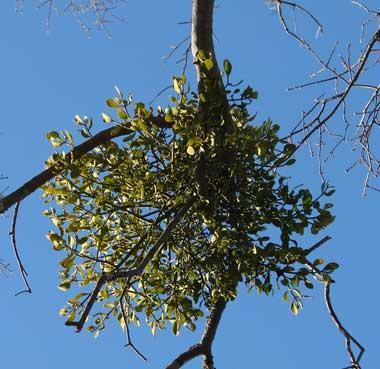Nature: Magical mistletoe

Don't let those Christians fool you – kissing under the mistletoe into the house is an old pagan ritual, says Éanna Ní Lamhna
I must confess, I always thought that mistletoe did not grow in Ireland except in the Botanic Gardens in Dublin, where it had presumably been planted on purpose. So I was interested to read an appeal in this month's Irish Wildlife magazine, asking people in Ireland who have mistletoe growing on trees in their area, to send in the records to Charles Nelson – formerly of the Botanic Gardens himself. He informed us that mistletoe is known to occur in counties Waterford, Wexford, Carlow, Dublin, Armagh, Down and Antrim, and wondered if it might exist elsewhere.
Mistletoe is an evergreen, parasitic plant, that grows on the branches of living trees. Unlike ivy – which has roots in the ground and merely uses the tree as a physical support – mistletoe draws some nourishment from the sap of the living tree, although it does of course photosynthesise for itself, with its green leaves. Flowers form on the mistletoe between February and April, but the white berries are a winter phenomenon and indeed grace the sprigs we buy to hang up in our halls over the Christmas period. These berries are eaten by hungry birds, particularly thrushes (hence, the Mistle Thrush), and the sticky berries adhere to their beaks. They wipe them off as they perch in other trees – the berries get stuck in cracks in the bark and the plant becomes established. Interestingly, in Ireland, it has not been recorded on oak but on apple trees, crab apples, lime, poplar, rowan and Norway maple.
But why do we bring it into our homes and kiss under it? Mistletoe was revered by the Celts who thought it was a magic plant that could cure all ills. Kissing under it, you'll be glad to know, is the remnant of a druidic fertility rite. There was no ancient tradition of this in Ireland however – the custom was introduced here in relatively recent times, by the English.
The whole custom of bringing greenery indoors is indeed a very ancient one. Midwinter Day, 21 December, was celebrated by the Norse with their Yule customs. On this day, holly, ivy and conifers were used to symbolise the eternity of life. Fires were lit in honour of Thor and kept alight until the shortest day had passed, hence, the yule log (which is now remembered as a chocolate Swiss roll). The Celts retained some of these Norse customs such as bringing in evergreens – which for them included mistletoe – and they feasted on a type of gruel called plum porridge.
When the Roman Emperor, Constantine, converted to Christianity in the 4th century, he decided that the Roman Festival Saturnalia, which welcomed back the sun after the shortest day had passed, should be Christianised. The Christian explanation for the use of holly, is that the red berries and prickly leaves, recall Jesus' crown of thorns and drops of blood . Don't believe a word of it – we bring these evergreens into our homes at the darkest time of the year to celebrate the sun. These living green things are proof that the sun hasn't died. It will stop getting lower in the sky and come back. And, do you know, the magic has never failed yet.
Happy Winter Solstice!
